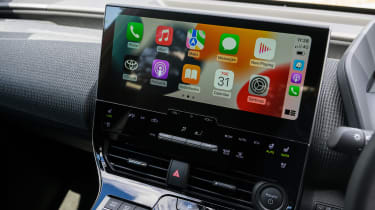Toyota bZ4X review: interior, dashboard & infotainment
Slightly awkward driving position aside, the bZ4X boasts a well-built interior with a superb infotainment system
Step inside the Toyota bZ4X’s interior and it feels a world away from the relatively conservative Corolla’s cabin. The star of the show is certainly Toyota’s latest infotainment system, but what we can say is apart from one confounding flaw, the bZ4X’s interior is hard to fault, with strong build and material quality across the board and an ergonomic layout.
Toyota bZ4X dashboard
Let’s get this out of the way quickly: Toyota made a mistake by copying Peugeot’s i-Cockpit. Like on the smaller Peugeot E-2008, the bZ4X requires the driver to position the steering wheel low in order to peer over the top and view the dials. It’s not quite as uncomfortable as in the Peugeot, which constantly has you bashing your knee against the wheel whenever you turn, and we appreciate how at least the instrument cluster does move with the wheel itself, making it at least slightly easier to see. That being said, the whole setup does feel a little contrived and as if you’re driving a go-kart, rather than a massive electric SUV – and we don’t mean that in a good way.
Regardless, the bZ4X’s small instrument cluster displays all the necessary information, but is nowhere near as configurable, nor as useful, as the larger display in the Nissan Ariya, which is able to showcase full-on maps and sat nav directions. The physical toggles for the climate controls feel solid and provide a good balance against the raft of other touch-sensitive buttons. We also like the fabric on the dashboard, which looks much more premium than swathes of black plastic.
Equipment, options & accessories
As of the time of writing, Toyota bZ4X is available in three distinct trim levels. Opting for the front-wheel-drive powertrain is the only way to get the cheapest ‘Pure’ model. This comes well-equipped as standard – as it should, give the Toyota’s relatively high starting price – getting an eight-inch infotainment system with smartphone connectivity, front and rear LED lights, dual-zone air conditioning, and a suite of safety systems including adaptive cruise control, lane-keep assist and a reversing camera.
Next up is the mid-spec ‘Motion’ model which, in our view, is the sweet spot in the range. Costing around £3,500 more than the base car, Motion trim adds a larger 12-inch infotainment system as well as part-synthetic leather upholstery, heated electric front seats, a wireless phone charger, ambient lighting, blind-spot monitoring, a 360-degree camera and a sporty-looking boot spoiler for good measure.
Topping the line-up is the ‘Vision’ which gets luxuries like full leatherette upholstery, cooling and memory functions for the front seats, a self-parking function and a gesture-operated powered bootlid.
Infotainment, apps & sat nav
Perhaps its strongest asset, the Toyota bZ4X’s Google-based infotainment system is a perfect example of why car manufacturers should further lean on tech companies in order to develop their in-car software. Base cars with their eight-inch screen can stream sat-nav via the internet, while those with the larger 12-inch display and its more powerful processor, have it built-in. Toyota allows you to download several apps like Spotify, and overall the system offers lightning-fast response and is pretty straightforward to use.
Unfortunately, one red mark on the infotainment system’s otherwise clean score sheet is the quality of the reversing camera, which is a bit more Kidizoom than it is Canon. The last time we saw such a low-resolution camera on an EV was in the MG ZS, which costs around £15,000 less than the Toyota. At least one comes as standard, though.





